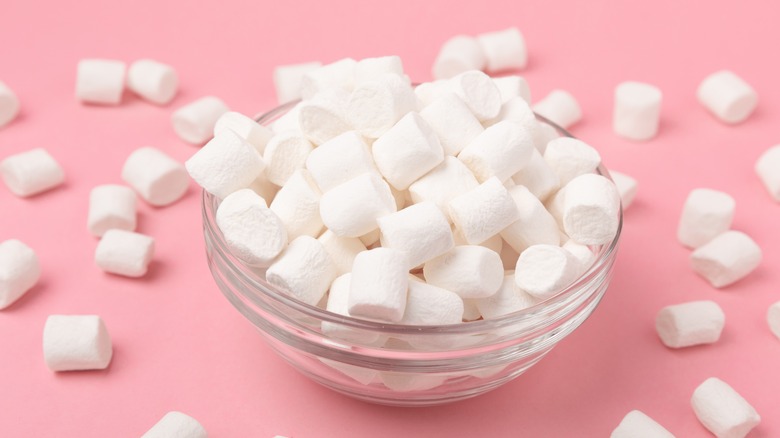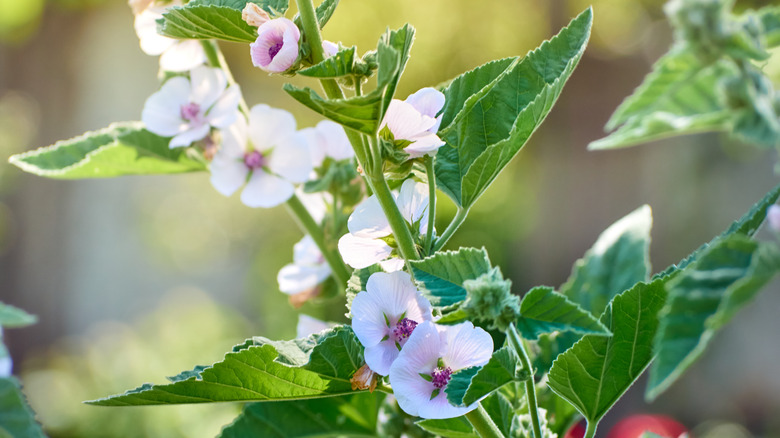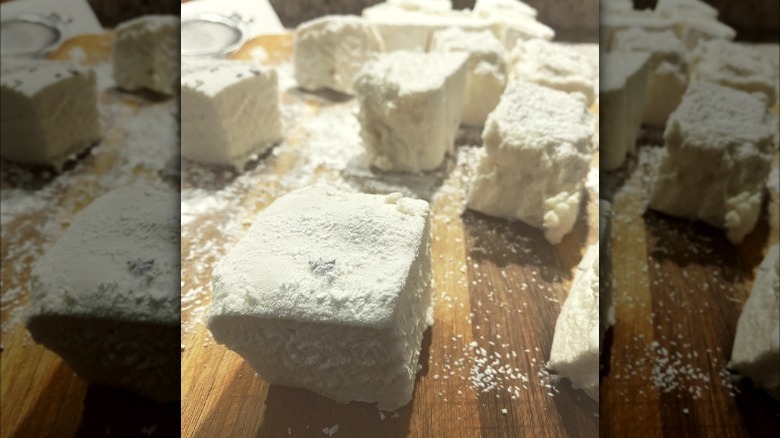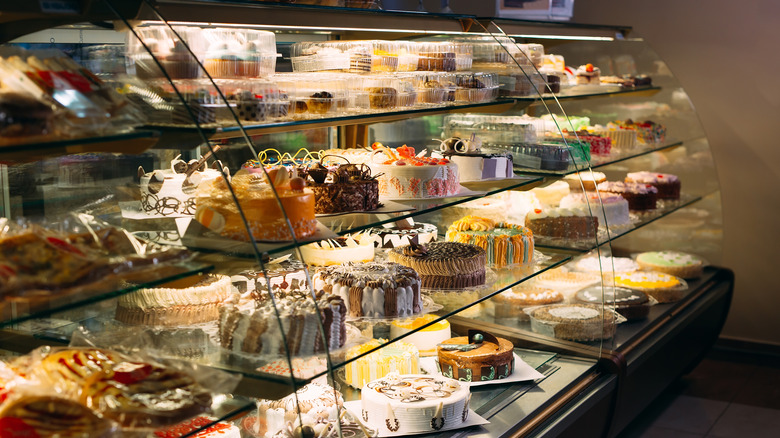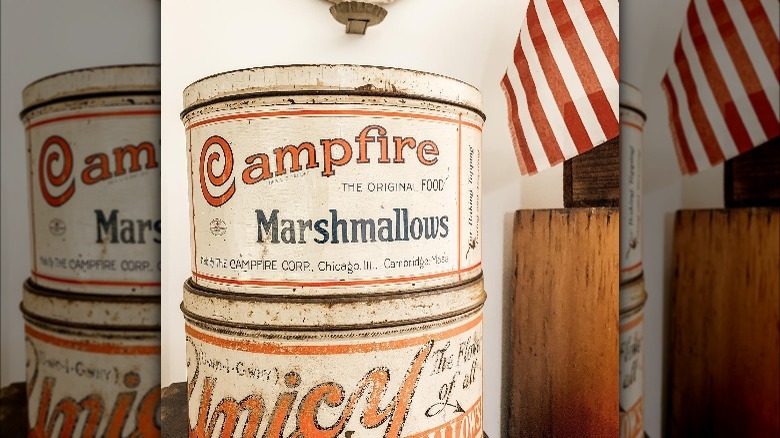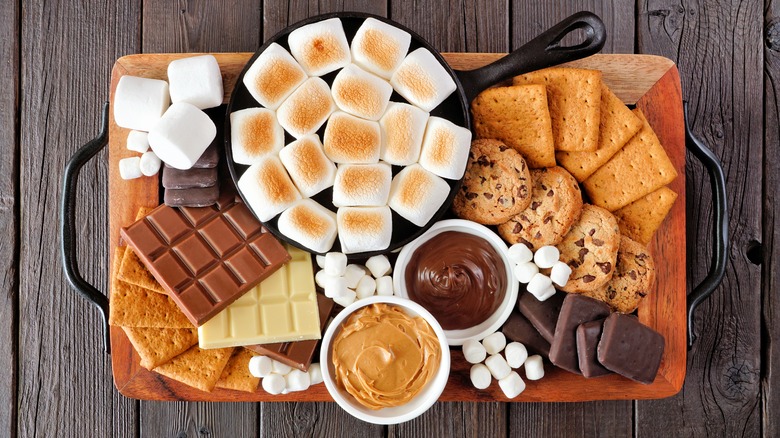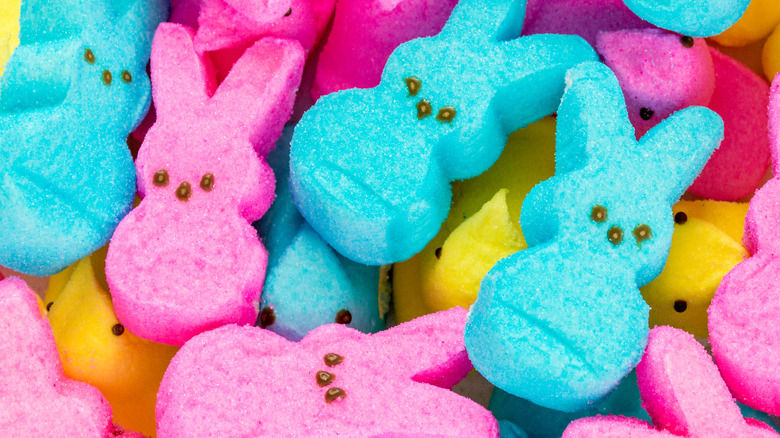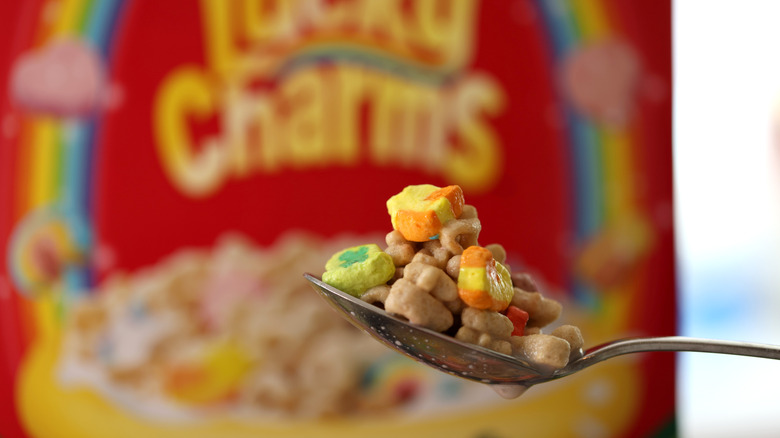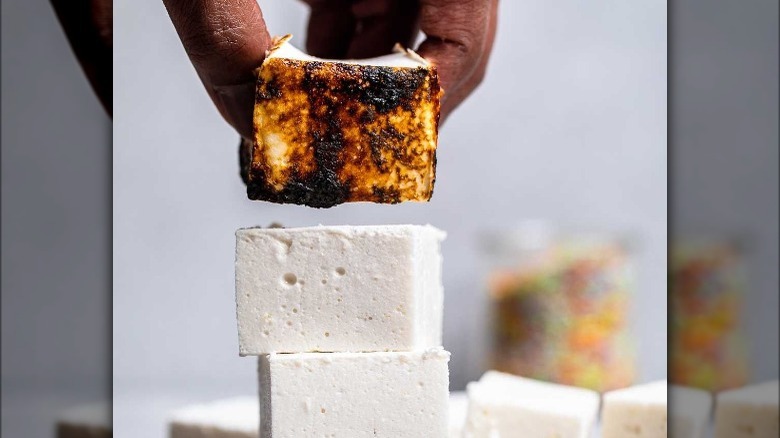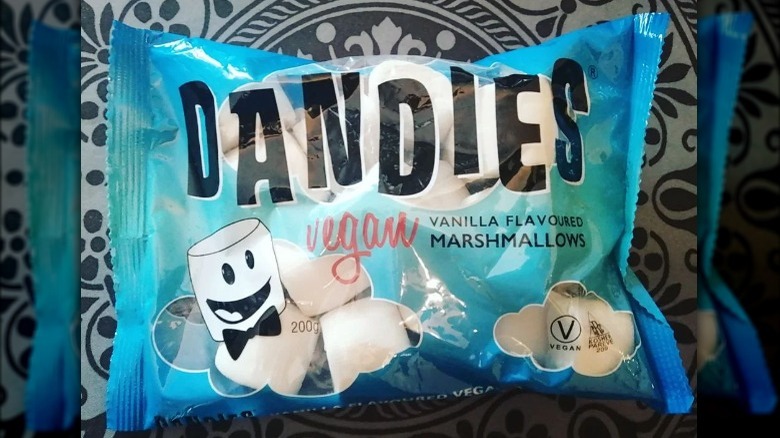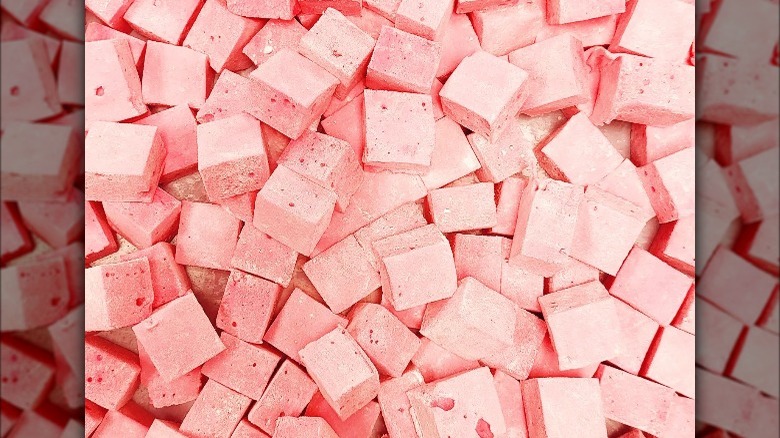12 Little-Known Facts About Marshmallows
There is simply no other candy that's quite as versatile as the marshmallow. After all, what better compliments a cup of cocoa, divisively fills an ambrosia salad, or tops a Thanksgiving sweet potato casserole? What else is preferred for roasting at the bonfire or using in chipmunk challenges? Who could imagine building miniature snowmen in front of a gingerbread house out of anything else? It seems like there's always a season and occasion for the marshmallow. There is arguably no other candy that Americans love so well and consistently. Proof is in the numbers. Market Watch reported in 2022 that Americans go through about 90 million pounds of marshmallows each year! This is a truly impressive number given that the treat is basically sugary-air.
Marshmallows feel so all-American that it probably comes as a shock that they are not. In fact, around the time modern marshmallows were being concocted overseas, there was a health food movement in the U.S. that actively rejected sugary treats, according to the Austin-American Statesmen. So, really, the popularity of marshmallows in the states is a tale of triumph and beating the odds! But this is really just a small piece of the wonderful and weird history that surrounds this simply sweet treat.
Marshmallows were originally derived from the marshmallow flower
The humble marshmallow really has a long history that traces its way back to the ancient world beginning with the marshmallow plant. Found in Eurasia and Africa, this flowering beauty grows along marshes, hence marshmallow (via Southern Living). But, the plant isn't just pretty to look at. Its root and sap have long been known to be both delicious and medicinal. As detailed by Herbalgram, the first reported use of the marshmallow plant is as early as 9th century B.C. in Greece. The Greeks knew the plant had therapeutic properties and soothed throat inflammation. But, this medicinal use wasn't limited to Greece. The marshmallow plant was widely used as a medicine in the ancient world.
Herbalgram reports that the marshmallow plant was widely used in the Arab world as well. It even earned a mention in the India's famous Ayurvedic pharmaceutical encyclopedia. The book observed, just as the Greeks did, that the plant's roots could be used to ameliorate coughs and even aid in healing serious afflictions like bronchitis. It's interesting to note that it seems like humans have been drawn to marshmallows for the longest time.
Ancient Egyptians were particularly fond of the plant
It's pretty clear that the plant had long entertained favor with many different civilizations, but it was arguably the ancient Egyptians who took a particular shine to the plant and approached it in an unprecedented way. As per Herbalgram, while uses were still medicinal, the plant's roots were also mixed with honey to make for a sweet treat. Boyer Candies observes that there's evidence that the Egyptians would even take the concoction and combine it with grains and bake it into a cake. It seems like even though it would be a long time before marshmallows turned into confection, the potential was there for it!
The marshmallow plant and its candy-like medicine were highly revered in ancient Egyptian society. Sadly, though, that meant the treat remained, according to both sources, safeguarded and very exclusive. So wonderful were these marshmallow medicines that they were reserved for gods and pharaohs. For the time being, marshmallows were a divine treat that no mortal could touch.
The French modernized the treat in the 19th century
Through the Middle Ages, marshmallows remained primarily medicinal in use and perspective. It took thousands and thousands of years before the marshmallow shifted to something more delightful. But if anyone was going to lean into the indulgence, it was going to be the French. The National Confectioners Association observes that by the mid-19th century, innovative French confectioners sought to explore the possibilities of the marshmallow plant. They took the marshmallow root and its sap and whipped it into the puffy form we know today. It is without exaggeration that I can declare that history was made! Smithsonian Magazine does note that even though the marshmallow first became a verified candy at this point, it was still quite different from what we know and gobble on today. As the magazine outlines, the original French version was more of a hybrid "between medicinal lozenge and bonbon."
It seems that there's something that humans just intrinsically love about the sweet treat. By all accounts, according to Smithsonian Magazine, the marshmallow was an instant success. As per the National Confectioners Association, candy makers found it hard to meet the instant and overwhelming demand — people could not get enough of the marshmallows. This struggle was due to the fact that each individual marshmallow was handmade, which was a time-consuming and labor-intensive task. Fittingly, due to demand and work put into the treat, marshmallows were an unusually expensive candy.
By the 20th century, marshmallows became mass-produced
As noted by Food Timeline, marshmallow production in those early days was not only expensive, but it was also time-consuming as they had to be made one by one! There was no running to the grocery store for a bag of puffy treats. Instead, one had to go to a specialty candy store or confectioner to order marshmallows. It was a luxurious and indulgent experience. By the 20th century, marshmallow mania was in full swing (via Food Timeline).
With this major demand for marshmallows, it seemed like only a matter of time before candy engineers would find a way for the marshmallow-making process to become both cost- and time-effective. It was about 50 years later that, according to ThoughtCo., a system was developed to create multiple marshmallows at a time. This method, the starch mogul system, used cornstarch as molds. Thus, the candy no longer needed to be made by hand — it could be cast. With that development, the cheap mass-produced marshmallow was made possible for the first time. Really, this was a much larger event in candy history, as we have this same system to thank for mass-producing jellybeans and candy corn, among others. Also, notably with this system, marshmallow root ceased to be used in the candy. Instead, candy-makers started using gelatin, which led to a longer shelf-life for the treat. Nonetheless, the name marshmallow had stuck. To this day the candy pays homage to its plant-based roots.
Angelus Marshmallows worked hard to Americanize marshmallows
In the late 19th century, the Rueckheim brothers emigrated from Germany and brought with them the candy-making knowledge and prowess that would reshape the modern American candy market (via Vice). The candy Wunderkind brothers were responsible not only for the first major introduction of the marshmallow but also the creation of the beloved Cracker Jack.
Whereas the Cracker Jack was a major stroke of innovation, the marshmallow really centered around a clever marketing strategy. The brothers knew that it was only a matter of time and energy before the delicious good struck America's sweet tooth. Intuitively, their company, Angelus Marshmallows, teamed up with the woman behind the renowned Boston Cooking School Magazine to develop recipes that utilized marshmallows, according to Vice. The result was a booklet that popularized such recipes as marshmallow-topped hot cocoa and sweet potato casserole that are still enjoyed to this day. Interestingly, Smithsonian Magazine credits not only the marshmallow's sweetness but rather its "thermoreversibility" — the habit of melting wonderfully when heated — to its novelty and eventual success stateside. Perhaps it was the catalog of recipes that paved the way for the American marshmallow to be as ubiquitous as it is today. Not all of the recipes were a stroke of genius, though. As Smithsonian Magazine notes, recipes like a marshmallow and mayonnaise salad were better left to the dusty halls of time.
In 1927 the Girl Scouts published the first s'mores recipe
As outlined by Smithsonian Magazine, the unique ooey-gooey texture that marshmallows take on when heated is part of America's attraction to the airy treat. This attraction may be no more evident than in the fact that it's a verified tradition to gather around a bonfire and roast up a pack of marshmallows. And really, what's could be better than a roasted marshmallow than a perfectly made s'more?
S'mores are truly iconic treats that seem to be completely American in nature. After all, what other combination would be indulgent enough to take the absolutely saccharine sweetness of a marshmallow, pair it with the pure pleasure of chocolate, and sandwich them between two Graham crackers? It should come as no surprise then that it's none other than the Scouts who are believed to have invented the dessert. In 1927, the Girl Scouts published the first known s'more recipe, as outlined by Scouting Magazine. It does make sense that such an indulgent recipe would be devised by the cookie masters themselves! The National Confectioners Association credits the Girl Scouts for whimsically naming the treat as a shorthand for "gimme some more." It seems like both the name and the treat stuck, and s'mores have solidified as a much-cherished fireside tradition.
By the '50s Peeps came to be
The marshmallow's versatility speaks volumes about its uses in a plethora of iconic dishes and recipes. After all, without marshmallow manufacturing, we wouldn't have the instantly recognizable Peeps! According to Vox, Peeps evolved not through the Angelus Marshmallows company but through the smaller Pennsylvania-based Just Born company. It seems a bit counterintuitive to take something already tooth-achingly sweet and then coat it in a layer of sugar, but that's the sort of indulgent madness that works for Peeps. And with two wax eyes and a cute little form, Peeps are just as visually interesting as they are delicious.
In 1953 the Just Born company acquired the Rodda candy company, which at the time was selling marshmallow-shaped chicks. The newly joined companies seemed to recognize the potential of the candy and quickly developed a method to whip them up in record time so they could be produced on a mass scale. Since then, Peeps have taken over as a treat to be enjoyed any time of year. They have even inspired artsy Peeps competitions. It's truly remarkable that marshmallows have a magnitude of success.
Marshmallows became a tool in an (in)famous Stanford experiment
Marshmallows even became a tool in some well-known scientific research in the early '70s. For those who are unfamiliar with the work, Stanford University devised a test that would long occupy academic and public discourse. The experiment looked into delayed gratification: Children ages 4 to 6 years old would be offered a marshmallow (or some other treat) but were told they could have two if they waited 15 minutes for the researcher to return to the room (via Vox).
The studies originally made waves, as sociologists and developmental psychologists theorized that those children capable of waiting might be set up for greater success in the future. It's interesting to note that marshmallows were meant to be the temptation to overcome in the experiment. The test was supposed to be a real trial of will for the young participants. Nowadays, the original test and the legitimacy of its findings have long been widely criticized, if not completely debunked as "not being possible to replicate" (via Northwest Educational Services). Thankfully, both adults and children these days can gobble on one marshmallow now or two later without any question about the larger meaning prescribed to their life.
By the '70s, marshmallow cereal rocked on to the scene
Saturday-morning cereal that's topped with marshmallows is a childhood staple that many adults fondly look back on, sometimes while still snacking on said cereal. While it's impossible to avoid seeing all the marshmallow-y cereals at the grocery store nowadays, this wasn't always the case. Mel Magazine observes that the practice of combining cereal and marshmallows is believed to have originated with the Rice Krispy treat around 1940. It wasn't until the '60s that cereal execs took the leap and started adding marshmallows directly to breakfast cereal. According to the magazine, one food engineer at General Mills was tasked with devising a new cereal, and he had the stroke of genius to top a wheat-based cereal with marshmallow bits. It's this very recipe that went on to become perhaps the most well-known marshmallow cereal: Lucky Charms!
It should be noted that cereal marshmallows have a sort of style of their own. Anyone who's munched down on them can attest to that. Delighted Cooking defines exactly what makes cereal marshmallow toppings different: They crunch in a way normal marshmallows don't, though they do take on a softer texture once getting splashed with some milk. That being said, cereal marshmallows never really get as fluffy as traditional marshmallows, presumably because they're dehydrated. These unique marshmallows have accumulated a significant amount of popularity given that in 2021 Lucky Charms started selling the cereal marshmallows exclusively – without the cereal — for the first time.
Controversy hits the vegan marshmallow scene in the '00s
While marshmallows technically got their start as a plant-based treat, they are made almost exclusively these days with animal-based gelatin (via VegNews). This has long ruled them out as a dessert for many different dietary preferences and beliefs. But as plant-based, kosher, and halal options are beginning to receive more accommodation, it looks like the timeless treat will soon be more accessible to the most diverse group of candy-enthusiasts. Helping with that push are the mavericks at Ben & Jerry's, who released a non-dairy take on their ever-beloved Phish Food complete with a vegan marshmallow swirl in 2021 (via VegNews).
The road to plant-based marshmallow goodness hasn't always been the sweetest. It also contains a bit of controversy. In 2007, before veganism began to sweep the nation, Sara Sohn opened up a vegan confectionary in the hopes of providing more alternatives in a food landscape that had slim pickings, according to a post with the Asian American Writers' Workshop. A vegan marshmallow was something she quickly perfected, using a kosher and vegan product called Emes Kosher-Jel. Sohn was distraught to find out later that Emes wasn't plant-based at all and contained animal protein (via VegNews). While this may seem like a small problem, it did disrupt trust in manufacturers at a time when there were few alternatives on the market. Thankfully, the market has diversified, and confectioners like Sohn can continue with a bigger choice of reputable brands.
Marshmallow trends are expected to change in the next decade
Alliance for Science observed in 2022 that more and more Americans are opting for a vegan or vegetarian diet and are looking for plant-based alternatives to classic snacks. It comes as no surprise then that vegan marshmallows are becoming more common. It's a sort of poetic parallel that vegan marshmallows largely started off in the candy store and eventually made it to the candy aisle as evidenced by Dandies Vegan Marshmallows.
But experts predict there's more change in store for the classic candy. Market Watch outlines that the biggest challenge for the candy right now is its nutrition and sugar content and believes that the market will see an increase in low-fat options and a wider variety of flavors beyond the classic vanilla flavor. If anything, though, the marshmallow has proved time and time again that it has staying power, all the while being more than capable of change. Another interesting observation from the study is that the American market is already so large that it's very unlikely to experience any further growth in the next decade or so. In turn, the study cites Europe as the largest potential market. Perhaps with the marshmallow "returning" to Europe, there will be more exciting and unpredicted changes for the candy.
Homemade marshmallows are trending in stores and online
Outside of the mass-produced marshmallows, some home chefs are returning to the almost lost art of marshmallow-making. A 2017 article from Tampa Bay Times noted that this falls within a larger trend of artisanal, handcrafted gourmet goods. Not only do handmade marshmallows give you some serious bragging rights (and insight into the OG marshmallow-making process), but they also allow for individual candy aficionados to experiment and concoct the most perfect marshmallow for themselves.
While it's been a few years since Tampa Bay Times took a deep dive into the handmade marshmallow scene, the trend still persists. One homemade marshmallow TikTok from 2021 wracked up almost 6 million views! If you're more of a marshmallow eater than a marshmallow maker, you'll be pleased to know that there are plenty of handmade gourmet marshmallow companies popping up. XO Marshmallow, for example, seeks to deliver a modern twist on the childhood classic that is both innovative and beautiful. Cookies and cream, Funfetti, and cotton candy are only some of the many flavors it offers for delivery!
